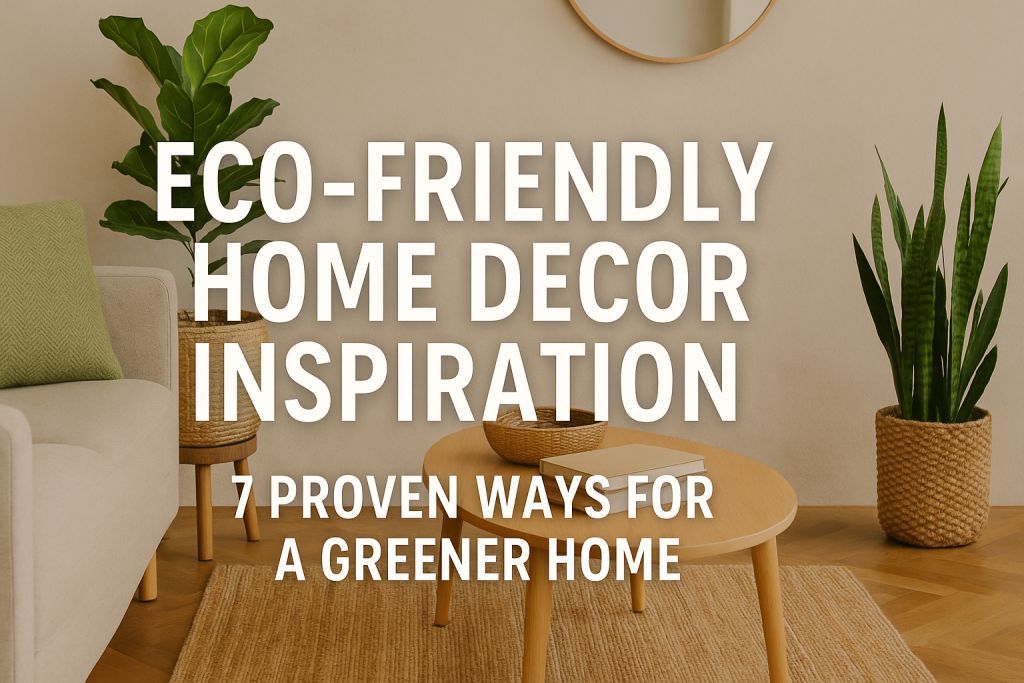Why Choose Eco-Friendly Home Decor?
Embracing eco-friendly home decor is more than a trend—it’s an impactful lifestyle choice. By integrating sustainable elements into your living space, you help reduce your carbon footprint, support ethical production, and create a healthier environment for yourself and future generations. According to the Environmental Protection Agency, the average American spends approximately 90% of their time indoors, making it vital to choose decor that’s safe and environmentally sustainable.
Eco-conscious decorating doesn’t mean sacrificing style or comfort. In fact, using green materials and innovative design ideas often results in distinctive, character-filled spaces. Whether you’re starting from scratch or updating your current decor, finding inspiration that aligns with sustainability can transform your home and your mindset.
1. Explore Online Platforms for Sustainable Design Ideas
Follow Eco-Inspired Instagram Accounts
Social media is a powerful tool for discovering sustainable home decor inspiration. On Instagram, countless influencers, designers, and brands share daily photos and ideas centered around green living. Search for hashtags like #ecohome, #sustainabledecor, or #greendesign to find curated feeds packed with innovative ideas, DIY projects, and product recommendations.
Discover Pinterest Boards Dedicated to Eco Decor
Pinterest is another invaluable resource for collecting and organizing eco-friendly decor ideas. Create your own board to save pins on topics such as recycled furniture, zero-waste interiors, and upcycling projects. For deeper dives, search for expert-curated boards from green-focused bloggers and interior designers, which can guide you toward both aesthetic and sustainably sourced decor solutions.
2. Visit Sustainable Home Decor Blogs and Websites
Dedicated eco-friendly lifestyle blogs offer endless ideas, practical tips, and in-depth product reviews for all things green. Sites like Eco Warrior Princess, My Scandinavian Home, and Sustainable Home feature everything from minimalist inspiration to how-to guides for upcycling old household items. These platforms often include real-life case studies, before-and-after transformations, and interviews with eco-conscious designers, making them a rich source of inspiration and practical information.
Many websites also provide lists of ethical and sustainable brands to shop from, helping you make informed purchases for your next home project. Don’t forget to check their resource sections for downloadable guides and checklists that you can use as you redesign your space.
3. Shop Locally and Support Green Artisans
Discover Local Artisan Markets
Supporting local craftsmen and artisans is both an eco-conscious and community-driven choice. Look for artisan markets, pop-up fairs, and local shops selling handmade or upcycled decor. These items often have a lower carbon footprint since they travel fewer miles from maker to home. Shopping locally also enables you to ask questions about materials and production processes, ensuring your purchases align with your sustainability values.
Choose Reclaimed and Recycled Materials
Many eco-friendly makers prioritize reclaimed wood, recycled glass, and other reused materials. Decorating with items crafted from repurposed materials not only adds unique character to your home but also helps conserve resources. Seek out furniture, wall art, or textiles that have a backstory—these pieces become meaningful conversation starters while promoting sustainability.
4. Draw Inspiration from Nature and Biophilic Design
Incorporate Indoor Plants
Biophilic design focuses on creating a connection between your living space and the natural world. Adding indoor plants is a simple yet powerful way to boost both aesthetics and indoor air quality. Choose low-maintenance varieties like pothos, snake plants, or peace lilies for a lush, eco-friendly atmosphere. Not only do plants purify the air, but they also reduce stress and foster a sense of well-being.
Use Natural and Organic Materials
Opt for decor elements made from renewable resources such as bamboo, cork, jute, or organic cotton. These materials are biodegradable and often require fewer resources to produce compared to synthetics. Incorporate woven baskets, linen throws, or bamboo blinds to achieve a warm, earthy look that aligns with sustainable principles.
5. Repurpose, Upcycle, and DIY
Transform Old Furniture Into Treasured Pieces
Before discarding old furniture or decor, consider how you can give it new life. Simple upgrades like sanding, painting, or reupholstering can dramatically transform outdated pieces. Upcycling not only prevents waste but also allows for customization to match your unique style and needs.
DIY Decor Projects with a Green Twist
Take on DIY projects using reclaimed or sustainable materials. Create wall art from driftwood, craft shelves from old crates, or make candle holders from recycled jars. DIY not only saves money but also lets you infuse your home with personal touches that reflect your commitment to sustainability.
6. Leverage Sustainable Brands and Certifications
Shop from Certified Eco-Friendly Brands
When purchasing new items, look for brands with recognized certifications such as FSC (Forest Stewardship Council), OEKO-TEX, or Cradle to Cradle. These certifications ensure that products meet strict environmental and ethical standards. Many brands now offer full transparency about their sourcing and manufacturing processes, helping you make greener choices with confidence.
Review Product Life Cycles and Durability
Consider the longevity of a product before adding it to your home. Invest in high-quality, durable pieces that stand the test of time, rather than trendy, short-lived items. This reduces both waste and the need for frequent replacements. Many sustainable brands also offer repair services, further extending the lifespan of their products.
7. Attend Green Home Tours and Workshops
Participate in Sustainable Design Events
Many cities host green home tours, eco-design fairs, and sustainability workshops. Attending these events allows you to view real-life eco-friendly interiors, ask questions, and gather practical tips from experts. You might also discover local resources such as green architects or zero-waste stores that you hadn’t considered before.
Join Online Communities and Forums
Online groups and forums, such as those found on Reddit, Facebook, or dedicated sustainability websites, can be invaluable for sharing advice, inspiration, and resources. Engage with like-minded individuals, exchange ideas, and get feedback on your own projects. These communities often post updates about upcoming events, sales, and eco-friendly product launches.
Practical Tips for Starting Your Eco-Friendly Home Decor Journey
- Start small: Focus on updating one room or area at a time to avoid overwhelm.
- Set a budget: Eco-friendly doesn’t have to mean expensive. Many sustainable swaps are affordable or free.
- Prioritize function and durability: Choose pieces designed to last and serve multiple purposes.
- Stay informed: Keep learning about new materials, brands, and trends in sustainable design.
- Share your journey: Inspire others by showcasing your eco-friendly decor transformations on social media or blogs.
Conclusion: Create a Sustainable Sanctuary with Inspired Choices
Finding eco-friendly home decor inspiration is simpler and more rewarding than ever. By leveraging digital platforms, exploring local markets, connecting with nature, and prioritizing ethical brands, you can design a home that reflects both your personal style and your commitment to the planet. Remember, every small change adds up—your sustainable choices can inspire a ripple effect, encouraging friends and family to create their own green sanctuaries.
Start your journey today by exploring just one of these proven methods—and transform your space into an eco-conscious haven you’ll love for years to come.


